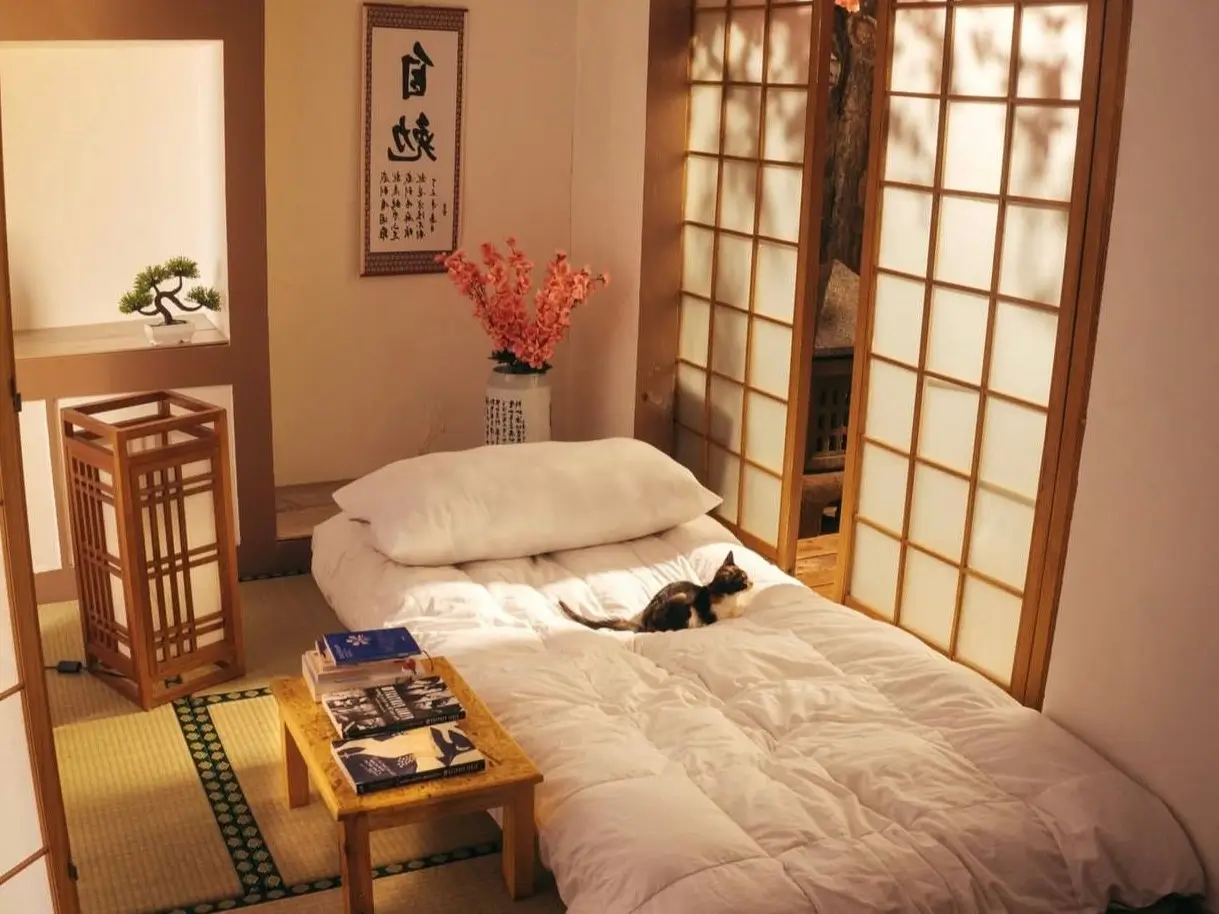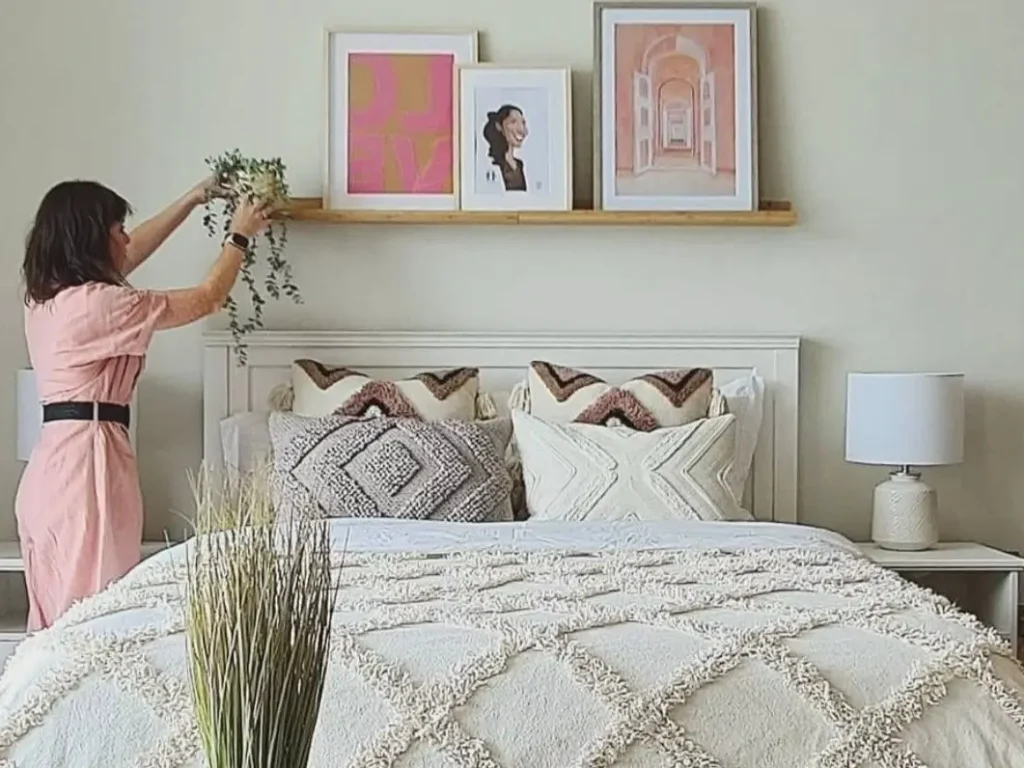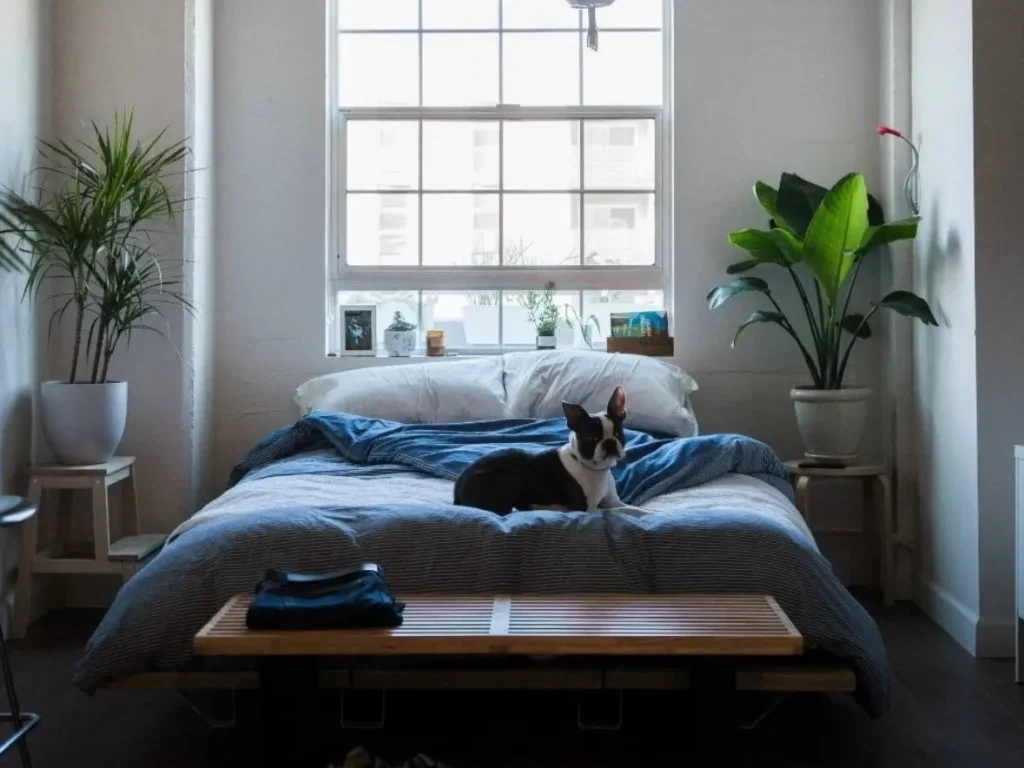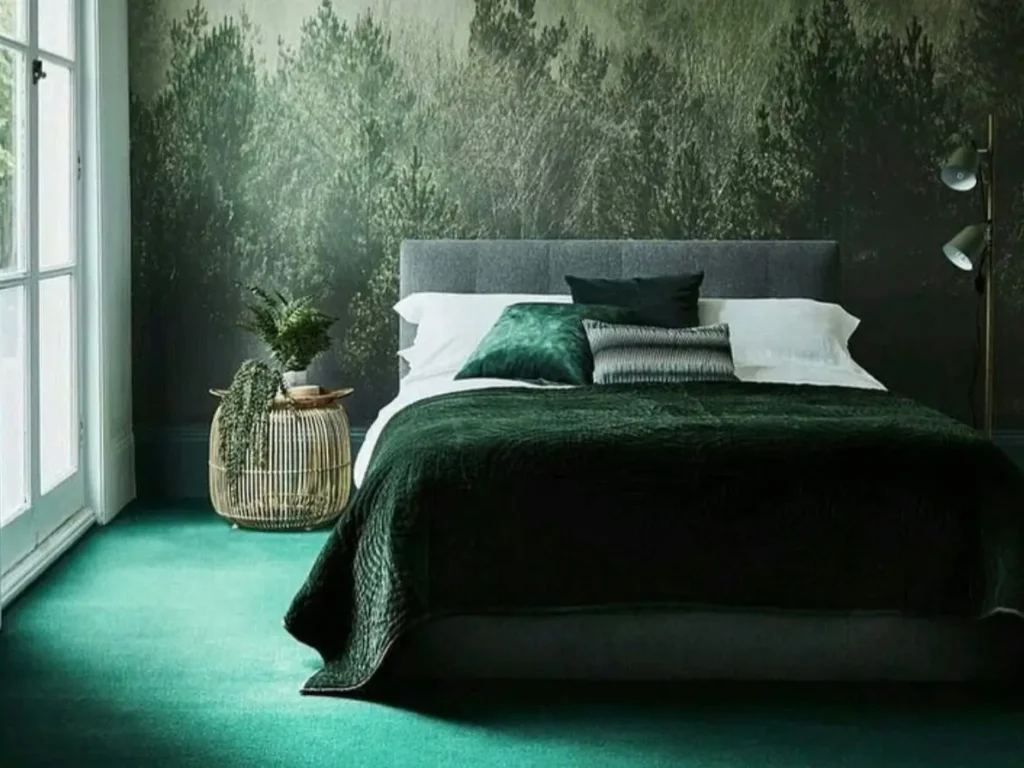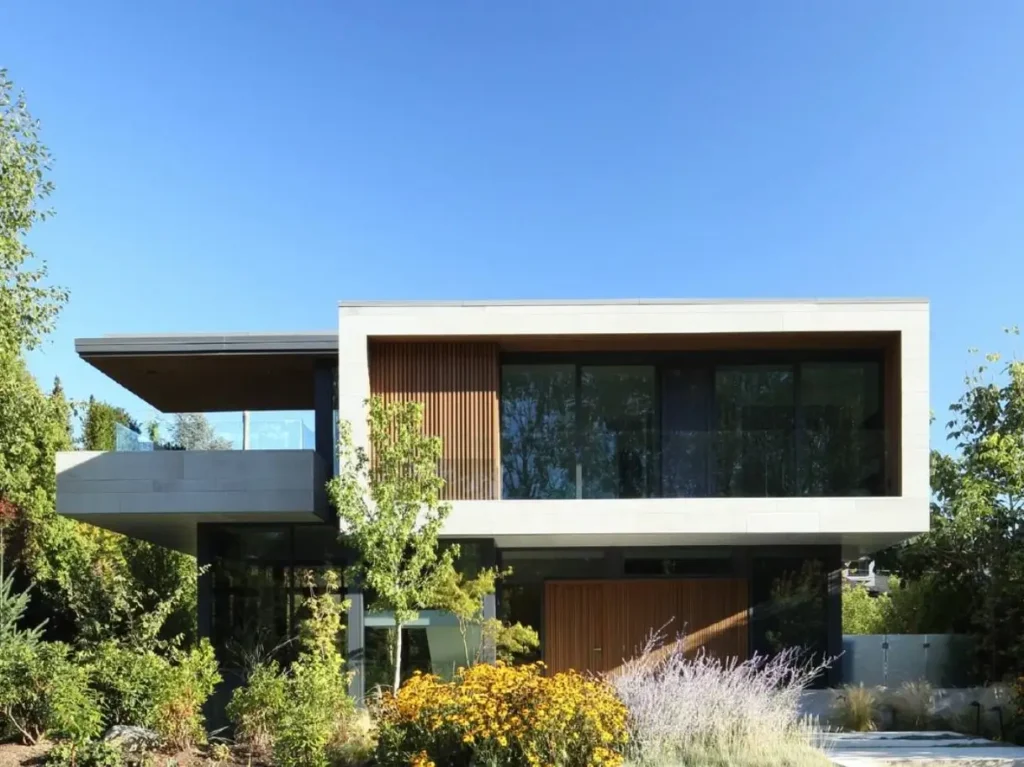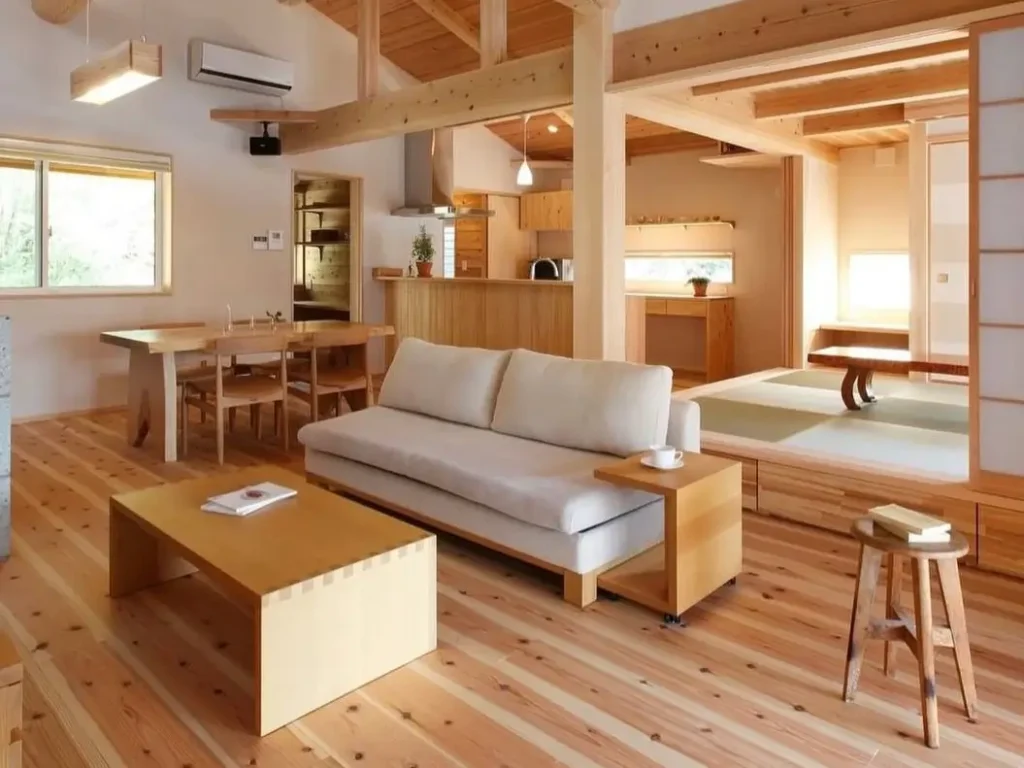Genuine tranquility is the very essence of Japanese bedroom design. This philosophy, central to Japanese bedroom ideas, moves beyond mere aesthetics to transform a space into a serene, Zen-like retreat that quiets the mind and restores the spirit. It prioritizes a deep connection to nature, mindfulness, and an uncluttered sense of order.
Achieving this atmosphere hinges on intentional simplicity. True Japanese design is not about emptiness but a masterful balance of natural materials, low-profile furnishings, and soft, diffused light. Every piece serves a purpose, contributing to an environment of functional, quiet elegance.
For those seeking Japanese bedroom inspiration, the goal is often to create a personal haven from a chaotic world. Whether you are planning a complete overhaul or wish to integrate key principles, these Japanese bedroom design ideas and Japanese style bedroom design concepts offer a timeless path to a more peaceful home.
Key Elements of Japanese Style Bedroom Design
Before exploring specific Japanese bedroom inspiration, it helps to understand the foundational principles that create this signature serenity. This design philosophy is a careful practice of balance, articulated through several key elements.
- Low-Profile Furniture: Furniture is typically low to the ground, fostering a grounded, centered feeling. This includes low platform beds, short-legged tables, and floor cushions to make the room feel spacious.
- Natural Materials: A deep reverence for organic materials is key. Light woods like bamboo and pine are common—a principle that defines the Japanese kitchen as well—as are stone, paper (for shoji screens), natural textiles like cotton, linen, and woven straw for tatami mats.
- A Neutral, Earthy Palette: The color scheme for a Japanese style bedroom design is drawn directly from nature. Soft whites, cream, beige, stone gray, and warm browns create a peaceful backdrop, while black is often used as a sharp, structural accent.
- Uncluttered Space (Ma): A crucial concept in Japanese aesthetics is Ma, the value of empty or negative space. The room is intentionally uncluttered, which allows the mind to rest and appreciate the few items chosen.
- Connection to Nature: The barrier between indoors and outdoors is often blurred. This is achieved through large windows, shoji screens framing a garden, or the simple placement of a bonsai or a single branch in a vase.
What is Japandi? A Modern Take on Japanese Bedroom Design
You will see many modern Japanese bedroom ideas that blend Japanese design with Scandinavian principles. This popular hybrid is called “Japandi.” It merges the sleek minimalism and natural elements of Japanese design with the rustic warmth and cozy comfort (hygge) of Scandinavian style. It is a perfect balance of serene elegance and functional, livable warmth.
22 Serene Japanese Bedroom Design Ideas
1. Embrace Natural Wood

Rich wood tones establish a warm, organic foundation, a common theme in Japanese bedroom ideas. This room utilizes timber extensively, from the flooring and low bed frame to the live-edge work desk. Paired with a traditional calligraphy scroll, the design feels both grounded and deeply personal.
2. Integrate Shoji Screens

Shoji screens are a defining feature, beautifully diffusing natural light to create a soft, ethereal glow. Paired here with traditional tatami flooring, these sliding panels connect the room to the outside view while maintaining a sense of privacy and peace.
3. Modern Botanical Mural

Modern interpretations can be soft and artistic. A delicate botanical mural behind the bed evokes nature, a core Japanese principle. This design pairs the artwork with a low platform bed and warm, light wood furniture for a clean, contemporary feel.
4. Mix Wood and Concrete
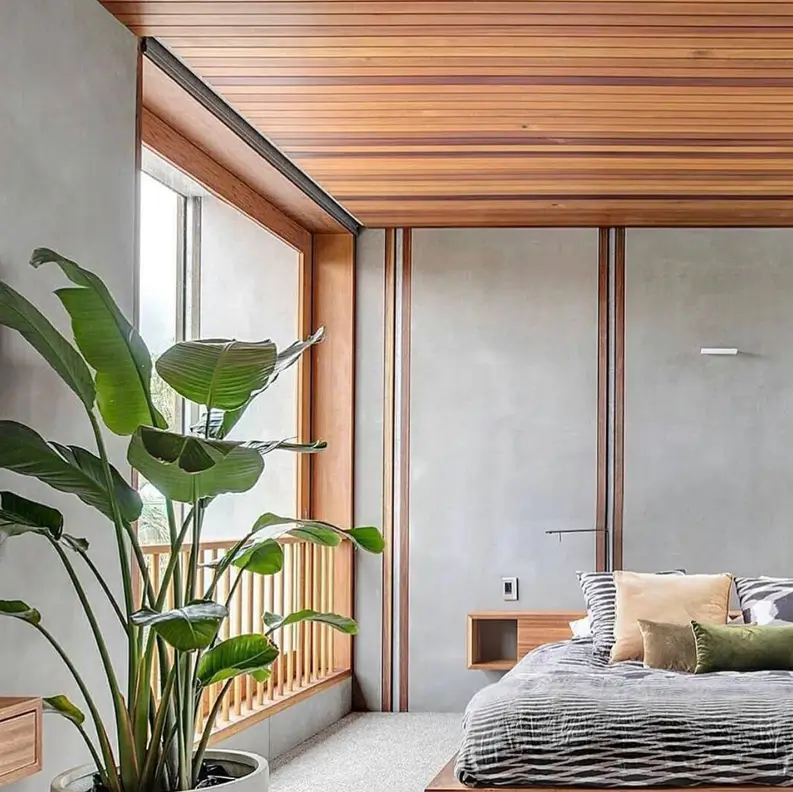
Texture provides warmth in minimalist design. This room masterfully contrasts a slatted wood ceiling and window frames with cool, smooth concrete walls. A large potted plant by the window further emphasizes the connection to nature, softening the modern materials.
5. Create a Luxe Focal Point
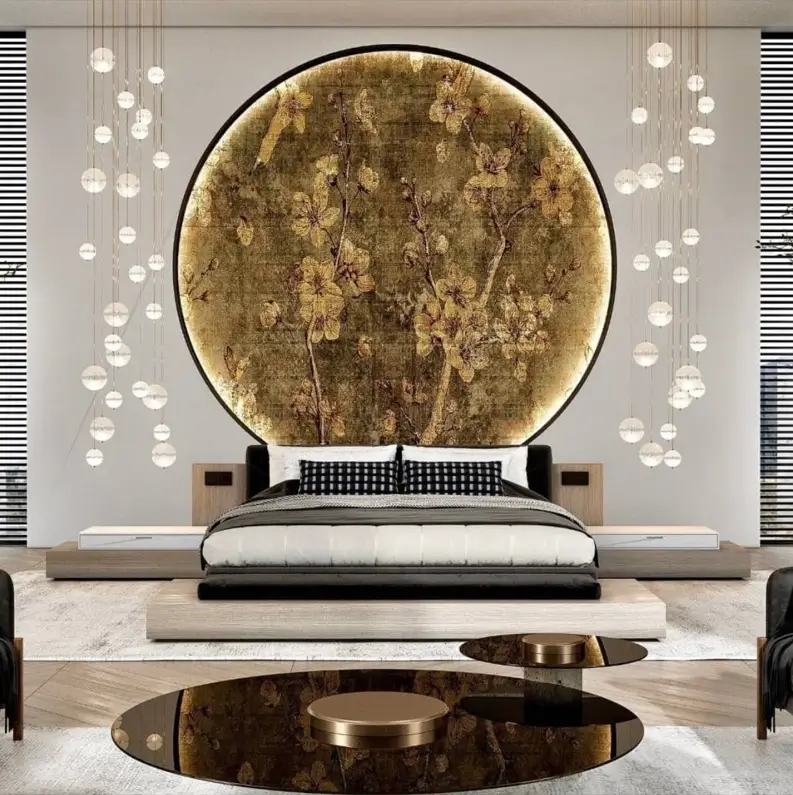
Dramatic focal points define this luxe design. A large, backlit circular panel with a gold blossom motif serves as an opulent headboard. This, combined with cascading pendant lights and a low platform bed, reinterprets traditional Japanese themes into a glamorous, modern statement.
6. Create Multi-Level Zones

Raised wooden platforms add architectural interest. This Japanese bedroom design idea cleverly zones the room, creating a dedicated sleeping area and a lower level for a built-in desk and floor seating. It is a smart way to separate rest from work.
7. Use Warm Neutrals
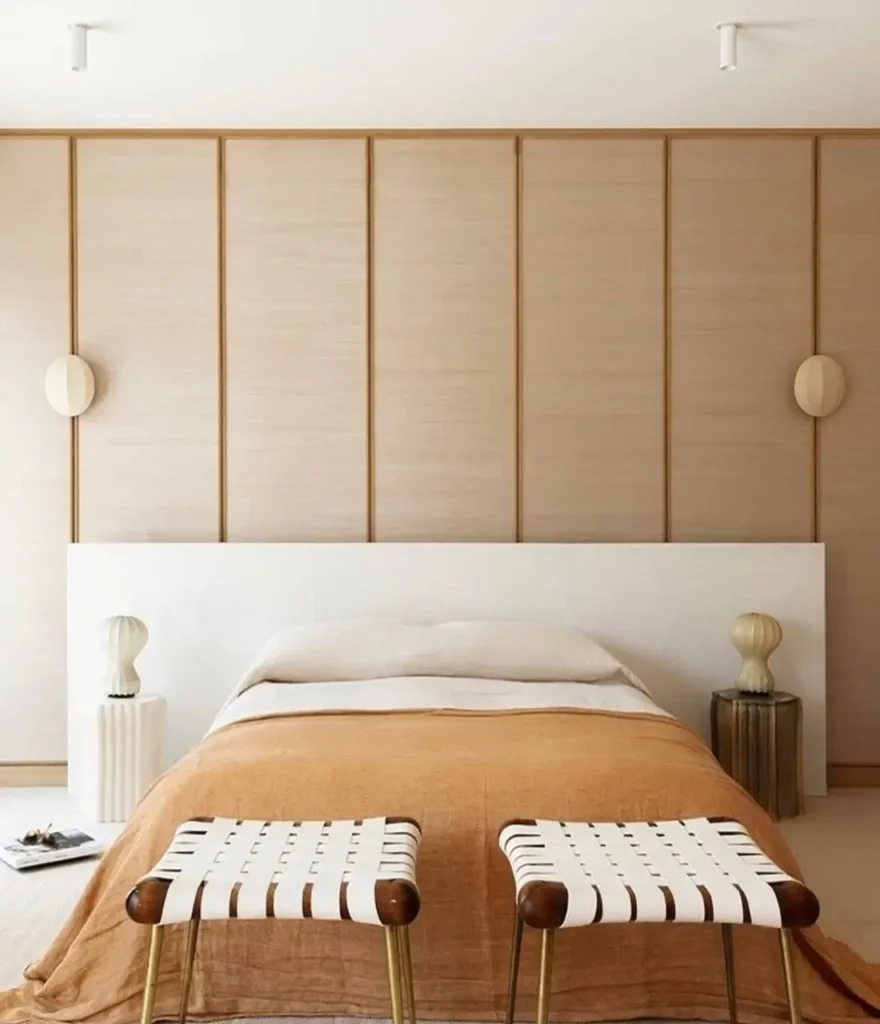
Warm, earthy tones create an instantly calming atmosphere. This room relies on a palette of terracotta, beige, and light wood. The paneled accent wall behind the low headboard adds subtle structure, enhancing the room’s serene, minimalist feel.
8. Traditional Tatami Floor

Tatami matting provides a firm, natural flooring base. This setup is designed for a futon, which can be folded and stored away during the day, maximizing the room’s function. The green walls add a calm, earthy tone to the space.
9. Serene Floor Sleeping
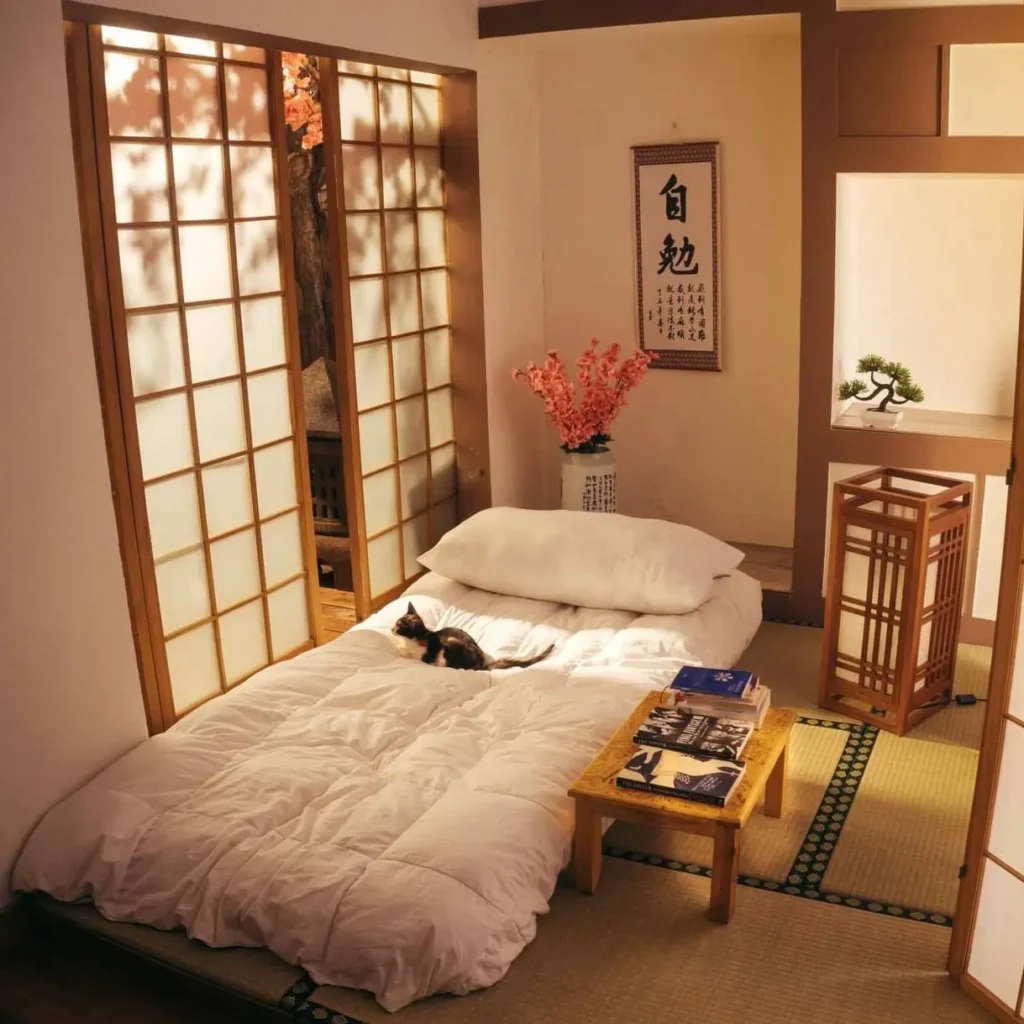
Floor sleeping on a futon is central to traditional Japanese bedroom inspiration. Placed on tatami mats, it offers a simple, uncluttered aesthetic. This room is completed by shoji screens that diffuse soft light and essential elements like a low table and an andon lamp.
10. Vibrant Pattern Fusion
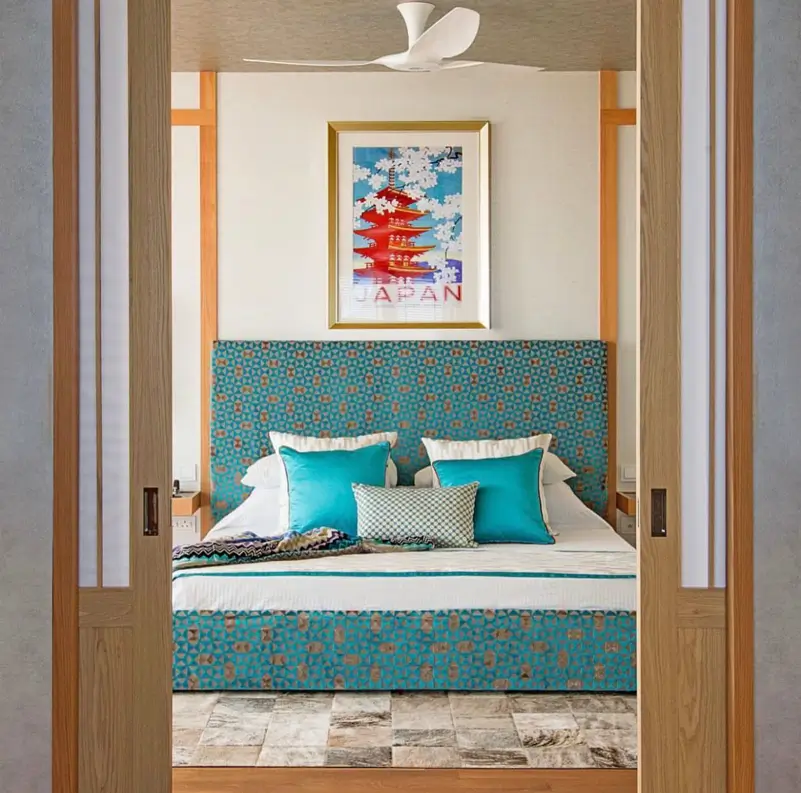
Japanese-inspired design can also be bold. This bedroom frames a vibrant, patterned headboard with simple wood posts. Sliding doors and a retro travel poster add to the eclectic mix, merging bright color with traditional architectural cues for a personalized look.
11. Iconic Art Mural

Iconic Japanese art provides a powerful backdrop. This mural, reminiscent of classic ukiyo-e prints, transforms the wall into a stunning landscape. Paired with a simple wood bed and neutral bedding, the artwork remains the undisputed focal point of the room.
12. Sculptural Feature Wall
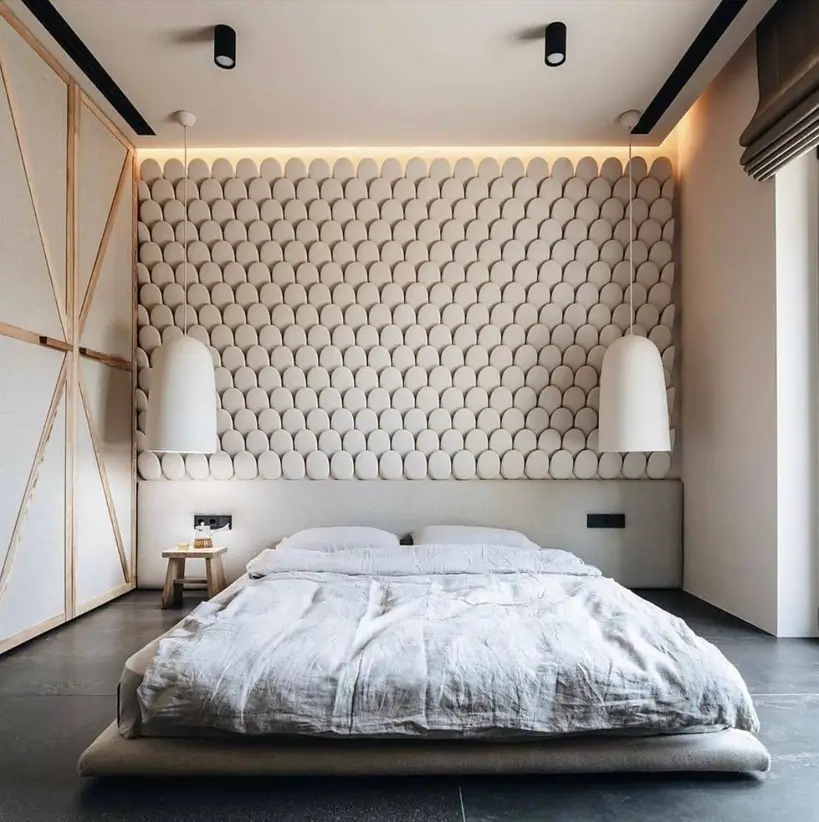
Soft, organic texture introduces a sculptural element, a sophisticated Japanese bedroom idea. This feature wall uses repeating, scale-like panels to create a tactile backdrop, beautifully lit from above. Paired with a floor bed and simple pendant lights, the room feels both modern and serene.
13. Hand-Painted Florals

Hand-painted floral motifs on a door panel add a custom, artistic touch. This room, seen in reflection, balances a warm terracotta palette and rattan textures with clean lines, creating a soft, personalized take on Japanese-inspired design.
14. Dramatic Mural Backdrop
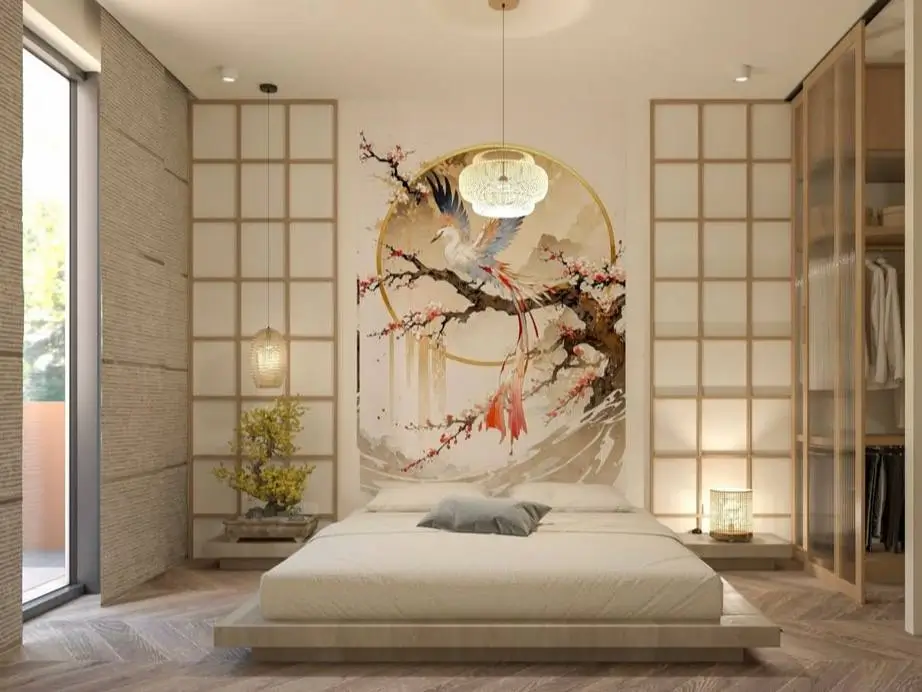
Stunning murals create a majestic focal point. This room features a large phoenix painting, flanked by shoji-style panels and a modern glass wardrobe. The design beautifully merges traditional Japanese elements with grand, artistic expression and a low platform bed.
15. Traditional Japanese Bedroom

Exposed dark beams and rich wood framing define this traditional space. A modern low bed rests directly on tatami mats, merging history with comfort. Warm, earthy wall tones and a view to an outer corridor complete the authentic, serene atmosphere.
16. Textural Japandi Design
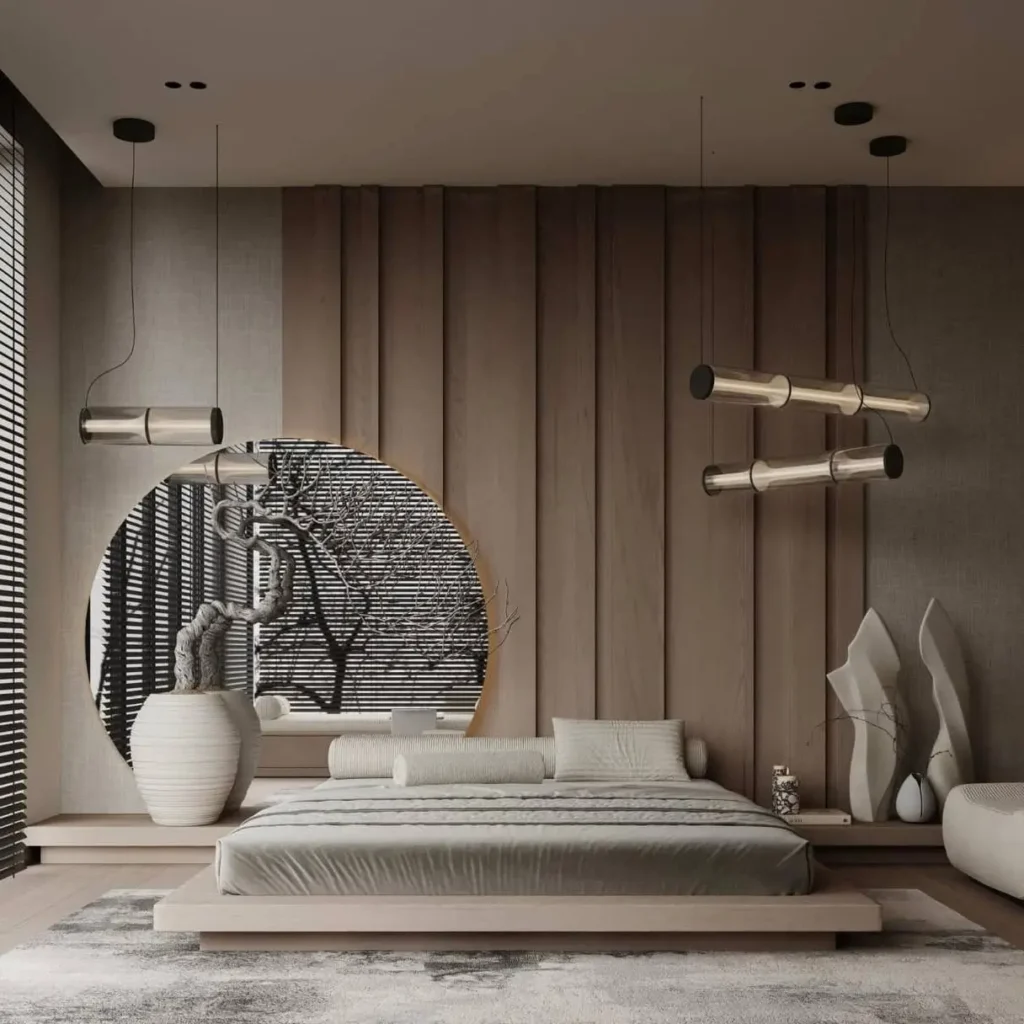
Vertical wood paneling and abstract sculptures create a rich textural landscape. This Japandi bedroom design idea blends Japanese minimalism with Scandinavian warmth, all united by a muted, earthy color palette and modern metallic lighting.
17. Moody, Rustic Bedroom

Dark, exposed ceiling beams and plank floors create rustic, moody Japanese bedroom inspiration. This room uses a low-profile bookshelf to cleverly divide the sleeping and living areas. A single branch in a vase adds a simple, natural touch to this tranquil space.
18. Use Wabi-Sabi Textures

Imperfect, natural textures are central to wabi-sabi. This bedroom features a rough plaster wall with organic alcoves, paired with a patterned wood headboard. The design celebrates asymmetry and craftsmanship, creating a space that feels both earthy and sophisticated.
19. Modern Paper Lanterns
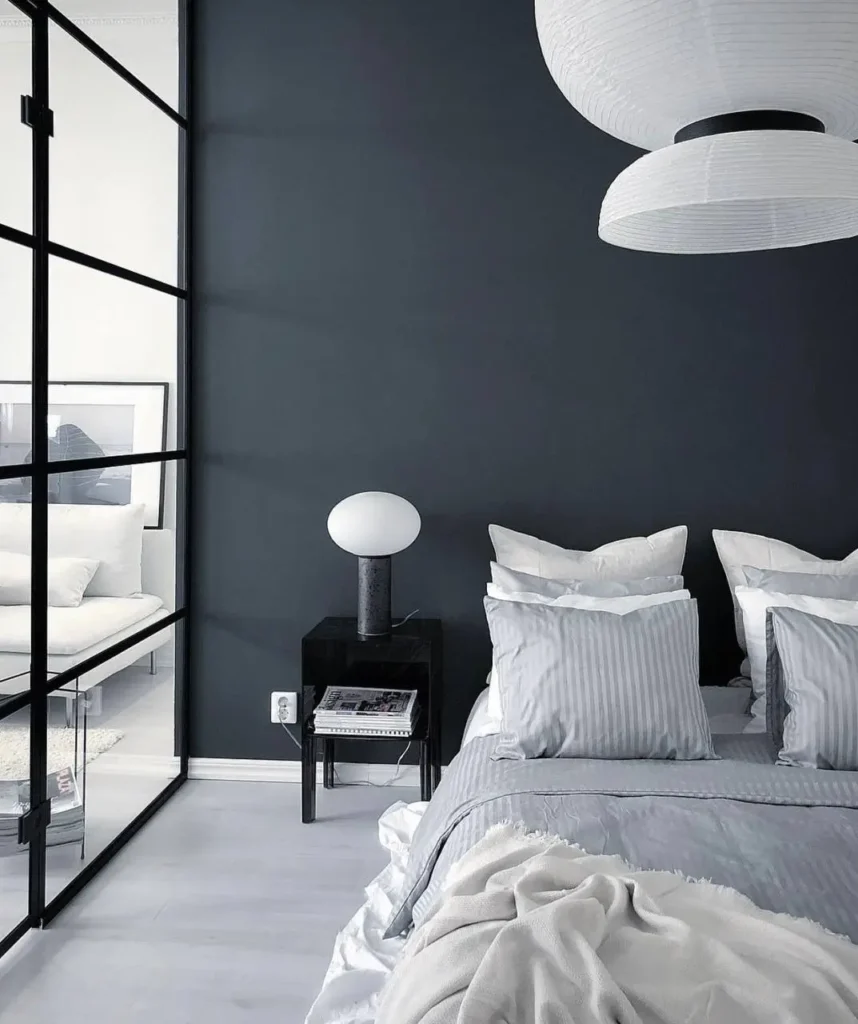
Paper lanterns introduce soft, diffused light, a classic Japanese element. This room creates a bold contrast by setting them against a dark, moody wall. The black-framed glass partition further enhances the sophisticated, modern interpretation of traditional forms.
20. Built-in Lattice Niche
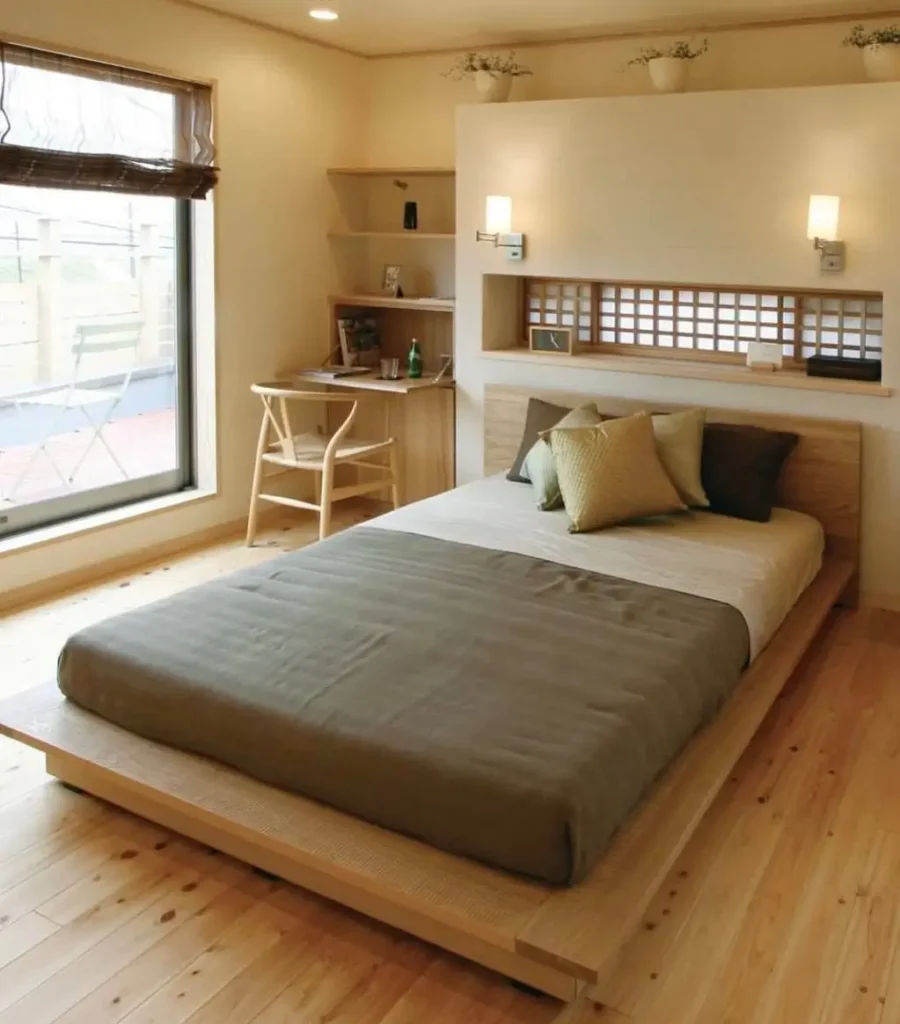
Built-in storage maintains an uncluttered feel. This bedroom features a recessed headboard niche with a traditional lattice screen, providing a display shelf. The design-forward approach seamlessly integrates with a low platform bed and matching light wood desk, creating a cohesive, functional space.
21. Japandi Symmetry
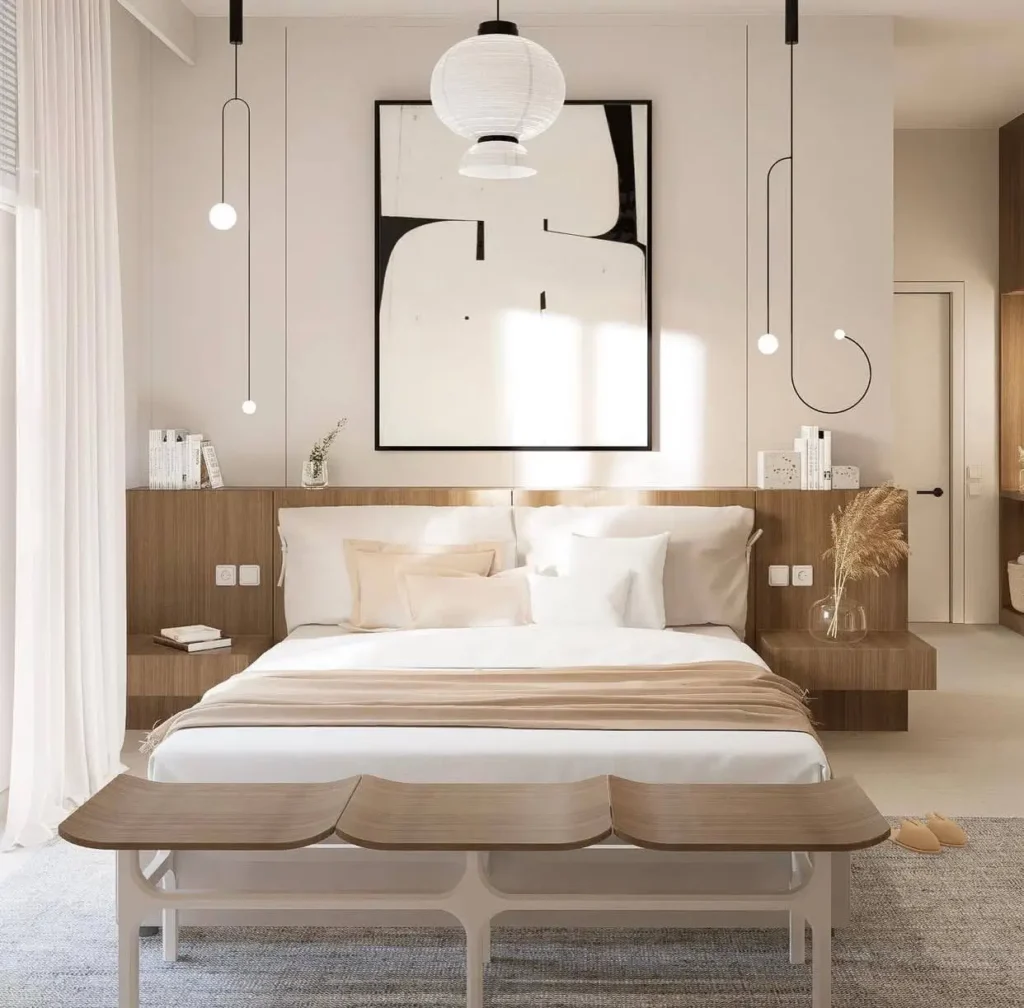
This Japandi bedroom by Hevi Studio masterfully balances Japanese wabi-sabi with Scandinavian hygge. Symmetrical lighting, featuring a paper lantern and sleek pendants, highlights the room’s core principles of simplicity, comfort, and function over a built-in wood headboard.
22. Integrated Vertical Storage
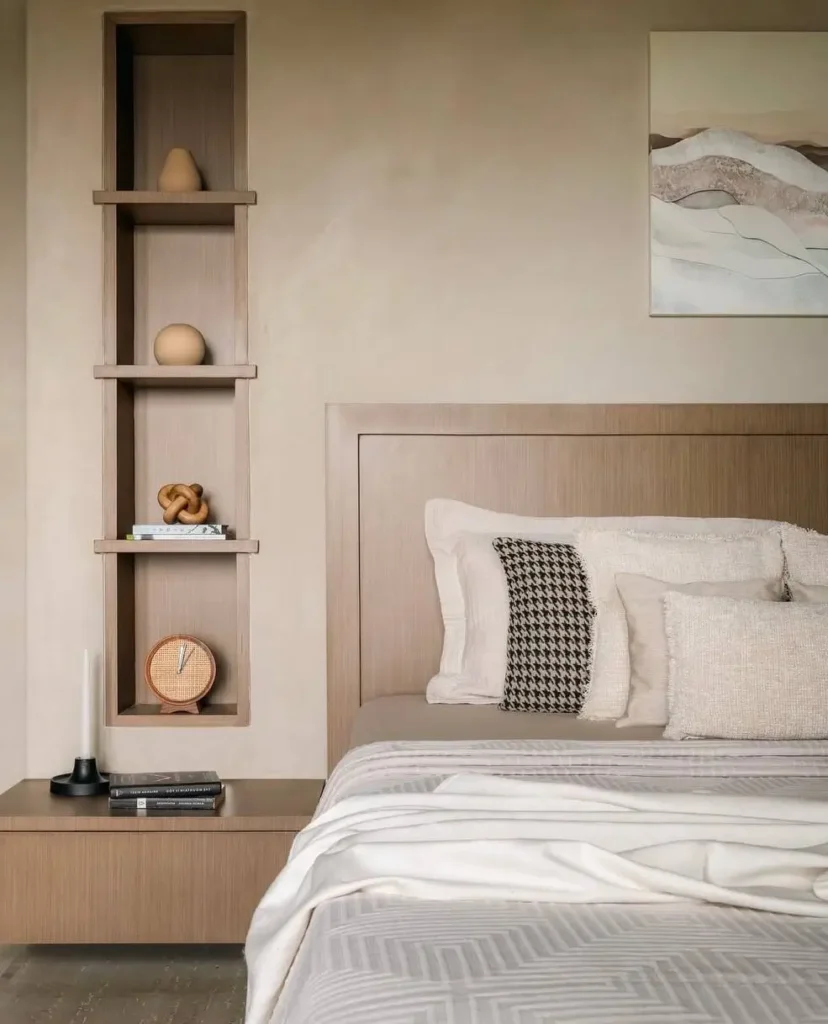
Vertical built-in shelving maintains a seamless look, a smart approach for any minimalist Japanese bedroom. This design uses a tall, recessed niche to provide curated display space. The matching wood headboard and floating nightstand create a cohesive, tranquil environment.
How to Get the Japanese Bedroom Look
Translating this philosophy into your own space is a practice of intention. The journey begins not with what you add, but what you take away.
1. Start with Subtraction (Embrace Ma)
The first step is always to declutter. Before buying a single new item, assess your room and remove anything that does not serve a purpose or bring you peace. This creates Ma, or “negative space,” which is the restful, uncluttered foundation essential to the style. This new, open space is an invitation to mindfulness, perfect for a quiet reading nook or a dedicated meditation space.
2. Establish a Natural Foundation
With a clear space, focus on the largest elements. The centerpiece is the bed, which should be a low platform frame or a futon. The goal is to bring you closer to the floor, creating a grounded feeling. Pair this with natural flooring, like light wood or bamboo.
3. Layer Light and Texture
Warmth is added not through clutter, but through texture and light. Swap heavy curtains for sheer linens or paper blinds that diffuse sunlight. Introduce natural textiles: a simple linen duvet, a cotton rug. The light itself, from a paper lantern, becomes a tactile element.
4. Curate, Don’t Decorate
The final step is to add only a few, meaningful items. This is not the place for a “gallery wall” or cluttered shelves. Choose a single piece of art, a beautifully crafted ceramic vase, or a living plant. Each item should have room to breathe. In a traditional Japanese room, this dedicated spot is known as the tokonoma—a small, recessed alcove for a single art scroll or floral arrangement.
Why Japanese Bedroom Design is Perfect for Small Bedrooms
The principles of Japanese bedroom design are a masterful solution for small spaces. The emphasis on minimalism naturally makes a compact room feel larger and more restful.
Low-profile furniture, for instance, draws the eye up and makes ceilings feel higher. Traditional sliding shoji screens or fusuma-style closet doors save valuable floor space, as they do not “swing” out into the room. A futon can be folded and stored, allowing a small bedroom to double as a work or meditation space during the day.
Beyond the Basics: Mastering Color and Light
While the principles are simple, their execution is an art form. Mastering color and light is what elevates a simple room into a serene sanctuary.
Understanding the Color Palette
The foundation is always neutral—shades of white, beige, and stone gray. However, accent colors are used with great intention. They are never loud, but deep and natural. Think of the dark blue of indigo dye, the rich green of a mossy forest, or the muted red of a persimmon. These are used sparingly, perhaps in a single cushion or a piece of art, to add depth.
The Art of Japanese Lighting
In Japanese design, light is not meant to flood a room; it is meant to create an atmosphere. Harsh overhead lights are avoided. Instead, the focus is on low, soft, and diffused light. Rice paper andon lamps and shoji screens glow warmly, and the interplay of light and shadow is celebrated as a design element in itself.
Frequently Asked Questions
What are the core principles of a Japanese bedroom?
A Japanese bedroom is built on three core principles: minimalism, a connection to nature, and a serene atmosphere. These foundational Japanese bedroom ideas are achieved through an uncluttered layout, the use of natural materials like wood and paper, a neutral color palette, and low-profile furniture that creates a-grounded feeling.
What is a Japandi-style bedroom?
Japandi is a popular hybrid design that merges Japanese minimalism with Scandinavian functionality. This Japanese style bedroom design combines the rustic, cozy feel of Scandinavian design (often called “hygge”) with the calm, elegant simplicity of Japanese aesthetics. Think neutral palettes, natural textures, and clean-lined, functional furniture.
What is a traditional Japanese bed called?
The traditional Japanese bed is a futon. This is a padded mattress designed to be placed directly on a tatami mat floor for sleeping. A key feature of the futon is that it can be folded up and stored in a closet during the day, a practical concept central to many Japanese bedroom design ideas.
Finding Your Own Personal Sanctuary
Ultimately, creating a Japanese-style bedroom is more than an interior design project; it is an exercise in mindfulness. It is about intentionally crafting a space free from distraction—from a tranquil Japanese bathroom to a Zen-inspired bedroom—allowing you to curate a personal, uncluttered retreat that calms the spirit and restores the mind.

